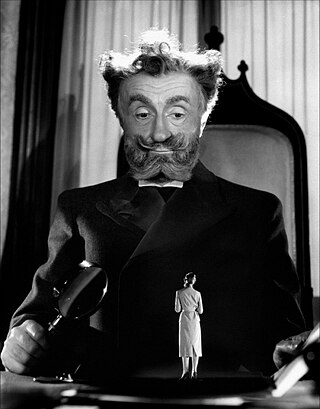
Special effects are illusions or visual tricks used in the theatre, film, television, video game, amusement park and simulator industries to simulate the imagined events in a story or virtual world.

A scale model is a physical model which is geometrically similar to an object. Scale models are generally smaller than large prototypes such as vehicles, buildings, or people; but may be larger than small prototypes such as anatomical structures or subatomic particles. Models built to the same scale as the prototype are called mockups.
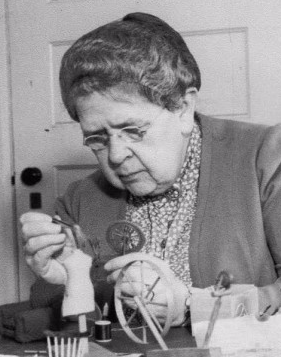
Frances Glessner Lee was an American forensic scientist. She was influential in developing the science of forensics in the United States. To this end, she created the Nutshell Studies of Unexplained Death, 20 true crime scene dioramas recreated in minute detail at dollhouse scale, used for training homicide investigators. Eighteen of the Nutshell Studies of Unexplained Death are still in use for teaching purposes by the Maryland Office of the Chief Medical Examiner, and the dioramas are also now considered works of art. Glessner Lee also helped to establish the Department of Legal Medicine at Harvard University, and endowed the Magrath Library of Legal Medicine there. She became the first female police captain in the United States, and is known as the "mother of forensic science".

Quilling is an art form that involves the use of strips of paper that are rolled, shaped, and glued together to create decorative designs. The paper is rolled, looped, curled, twisted, and otherwise manipulated to create shapes that make up designs to decorate greetings cards, pictures, boxes, eggs, and to make models, jewelry, mobiles, etc. Quilling starts with rolling a strip of paper into a coil and then pinching the coil into shapes that can be glued together. There are advanced techniques and different sized paper that are used to create 3D miniatures, abstract art, flowers, and portraits among many things.

A dollhouse or doll's house is a toy home made in miniature. Since the early 20th century dollhouses have primarily been the domain of children, but their collection and crafting is also a hobby for many adults. English-speakers in North America commonly use the term dollhouse, but in the United Kingdom and other English-speaking countries the term is doll's house. They are often built to put dolls in.

In miniature wargaming, players enact simulated battles using scale models called miniature models, which can be anywhere from 2 to 54 mm in height, to represent warriors, vehicles, artillery, buildings, and terrain. These models are colloquially referred to as miniatures or minis.
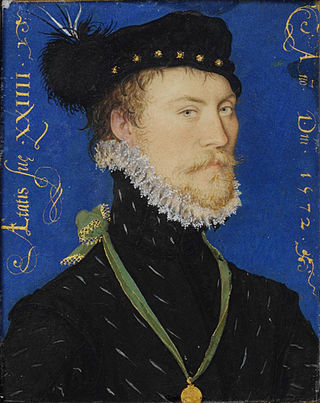
A portrait miniature is a miniature portrait painting, usually executed in gouache, watercolor, or enamel. Portrait miniatures developed out of the techniques of the miniatures in illuminated manuscripts, and were popular among 16th-century elites, mainly in England and France, and spread across the rest of Europe from the middle of the 18th century, remaining highly popular until the development of daguerreotypes and photography in the mid-19th century. They were usually intimate gifts given within the family, or by hopeful males in courtship, but some rulers, such as James I of England, gave large numbers as diplomatic or political gifts. They were especially likely to be painted when a family member was going to be absent for significant periods, whether a husband or son going to war or emigrating, or a daughter getting married.

Womanhouse was a feminist art installation and performance space organized by Judy Chicago and Miriam Schapiro, co-founders of the California Institute of the Arts (CalArts) Feminist Art Program and was the first public exhibition of art centered upon female empowerment. Chicago, Schapiro, their students, and women artists from the local community, including Faith Wilding, participated. Chicago and Schapiro encouraged their students to use consciousness-raising techniques to generate the content of the exhibition. Together, the students and professors worked to build an environment where women's conventional social roles could be shown, exaggerated, and subverted.
Miniature conversion refers to the practice of altering the appearance of a miniature or model so as to deviate from the standard version purchased in a boxed set.
1:144 scale is a scale used for some scale models such as micro/mini armor. 1:144 means that the dimensions of the model are 1/144 (0.00694) the dimensions of the original life-sized object; this equates to a scale of 1/2 inch per 6 feet of original dimension. For instance, an airplane 30 feet (9.14 m) in length would be a mere 2.5 inches (63.5 mm) long as a 1:144 scale model.
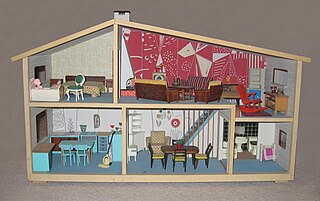
Lundby, also known as Lundby of Sweden, is a Swedish maker of dollhouses and miniature furniture for the mass market. Lundby dollshouse furniture has been produced since 1947 and their dollshouses have been sold since the late 1940s. The company started in the Gothenburg borough of Lundby, which also gave the company its name.
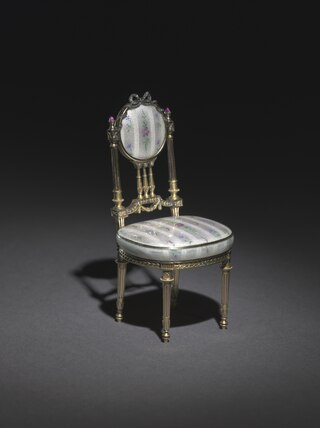
Miniature art includes paintings, engravings and sculptures that are very small; it has a long history that dates back to prehistory. The portrait miniature is the most common form in recent centuries, and from ancient times, engraved gems, often used as impression seals, and cylinder seals in various materials were very important. For example most surviving examples of figurative art from the Indus Valley civilization and in Minoan art are very small seals. Gothic boxwood miniatures are very small carvings in wood, used for rosary beads and the like.

The Nutshell Studies of Unexplained Death are a series of nineteen intricately designed dollhouse-style dioramas created by Frances Glessner Lee (1878–1962), a pioneer in forensic science. Glessner Lee used her inheritance to establish a department of legal medicine at Harvard Medical School in 1936, and donated the first of the Nutshell Studies in 1946 for use in lectures on the subject of crime scene investigation. In 1966, the department was dissolved, and the dioramas went to the Maryland Medical Examiner's Office in Baltimore, Maryland, U.S. where they are on permanent loan and still used for forensic seminars.
Howard Sheperd "Shep" Paine was a military historian and a collector of militaria best known for the more than three decades he spent as a modeler, sculptor, miniature figure painter, and champion of the diorama. Paine arguably did more than anyone else to forward the unique hobby/art form of military miniatures around the world, through his own pieces, numerous "how-to" hobby books, and championing of the "open system" of judging in use at many of the most prestigious modeling shows and exhibitions today.

Robert William Olszewski is a painter and miniatures artist primarily known for his work with Goebel and Disney, along with Harmony Ball Company and Enesco, LLC.

Narcissa Niblack Thorne was an American artist known for her extremely detailed miniature rooms. Her works depict historical interiors from Europe, Asia and North America from the late 13th to the early 20th century. The Thorne rooms are honored with dedicated exhibits in the Phoenix Art Museum, the Knoxville Museum of Art, and the Art Institute of Chicago, where a special wing was built to house them.

Astolat Dollhouse Castle is a museum-quality dollhouse, which was appraised as "the most valuable dollhouse in the world," at $8.5 million in 2015.

The Thorne miniature rooms are a set of approximately 100 miniature models of rooms created between 1932 and 1940 under the direction of Narcissa Niblack Thorne. Ninety-nine of the rooms are believed still to be in existence; the majority (68) are on display at the Art Institute of Chicago, while 20 are at the Phoenix Art Museum, nine at the Knoxville Museum of Art, and one each at The Children's Museum of Indianapolis and the Kaye Miniature Museum in Los Angeles. The Art Institute's rooms document European and American interiors from the late 13th century to the 1930s and the 17th century to the 1930s, respectively. Constructed on a 1:12 scale, the rooms are largely made of the same materials as full-sized rooms, and some even include original works of art.

Gabby's Dollhouse is an American live-action/animated/interactive preschool series created by Traci Paige Johnson and Jennifer Twomey for Netflix. In the series, which first premiered on January 5, 2021, In the show. Gabby and her cat friends go on adventures within her dollhouse.
Sherry Brody was an American artist and pioneering member of the feminist art movement. Brody is known for her work on the Womanhouse project. Her sculpture, The Dollhouse, is in the Smithsonian Museum of American Art collection.

















